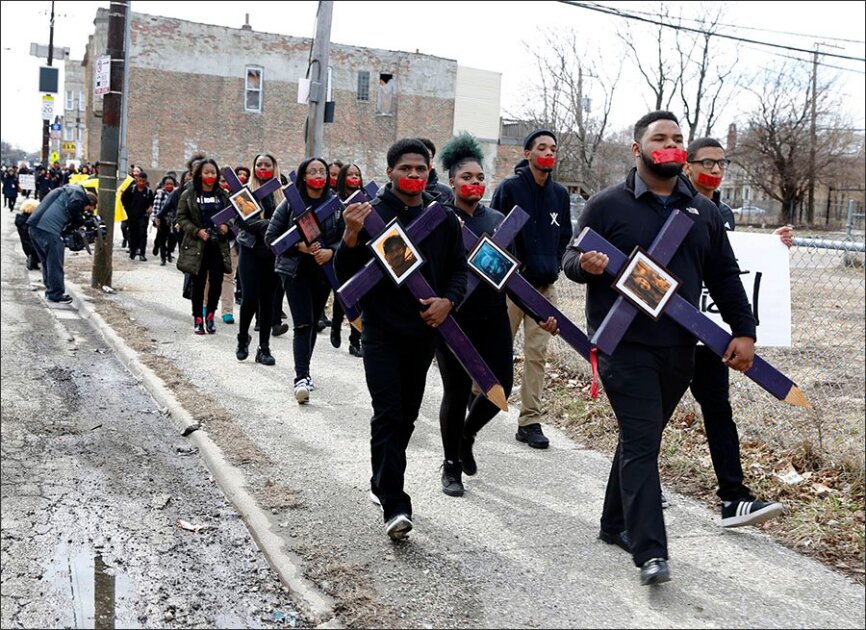As children witness rising violence on social media and in places where they study, worship, and play, questions grow about its effect on them.
Tragedies like the mass shooting five years ago today in a Parkland, Fla., high school can spark intense student engagement—the massacre at Marjory Stoneman Douglas High led to months of student protests against school and gun violence—but experts warn that over time, a widespread occurrence of school violence can desensitize students and undermine their sense of safety and engagement in school.
Even as their schools ramped up security protocols in the months following the Parkland shooting, Anne Thiselton-Dyer and Zoe Edelman, then-students at Acalanes High School in Contra Costa, Calif., watched their classmates disengage, scrolling on their phones and eating during lockdown drills.
“Student indifference towards drills implemented to stop school shooters is just one example of how the implications of violence have little to no emotional impact on younger generations,” Edelman and Thiselton-Dyer wrote in an essay on the Parkland shootings. “Violence surrounds us everywhere—news, media, movies, games—to the point where we begin to block it out.”
Educators and school leaders can help to counter this numbing effect and help students cope with violence on campus, in their communities, and in the media in healthier ways. Here’s what they need to know.
What is desensitization?
Simply put, desensitization is the tendency for a person to have a lower reaction to a stimulus or stressor if it is repeated often enough. In some situations, it can be a healthy coping strategy; for example, people who have phobias often go through a type of therapy in which they are gradually and repeatedly exposed to the thing they fear in order to reduce their response to it.
What makes students at higher risk for desensitization?
Students who experience violence across different contexts—such as both at school and in their community—can be at higher risk of becoming numb to it. One developmental study found that students who experienced violence in multiple areas of their lives at age 11 showed higher markers of emotional desensitization by age 13, as well as higher risk of aggressive behaviors at age 18.
“The emotional numbing that accompanies emotional desensitization to violence may contribute to the development of … emotional callousness and lack of remorse and empathy toward others,” suggested Sylvie Mrug, a psychology professor at the University of Alabama at Birmingham and the lead author of the study.
Desensitization doesn’t have to come from major violent events, such as a school shooting; smaller stressors such as bullying can trigger it, too. For example, one study of preteens and young adolescents found that students who were bystanders to cyberbullying—viewing derogatory social media posts towards classmates, for example—showed less empathy for bullying victims over time and more tolerance for bullying behavior online.
How can desensitization affect students?
Most research on desensitization has focused on students exposed second-hand, via violent media or community crime rates. Children and adolescents repeatedly exposed to violent media, for example, can develop more, rather than less, anxiety, as well as more symptoms of depression and less empathy for victims of violence.
“Not all injuries are visible,” notes guidance from the Centers for Disease Control and Prevention. “Exposure to youth violence and school violence can lead to a wide array of negative health behaviors and outcomes, including alcohol and drug use and suicide. Depression, anxiety, and many other psychological problems, including fear, can result from school violence.”
How should schools structure their response to violence to prevent desensitization?
In a new federal survey, more than 95 percent of school leaders reported having written procedures for what to do in the event of a school shooter, but fewer than a quarter of them felt prepared to deal with the aftermath of a shooting. For schools that experience a shooting or other violent incident on campus, planning long-term support for students and staff to cope with trauma can be critical.
In general, educators can prevent students from becoming numbed to violence by making them aware of their own disengagement and by providing outlets for them to both discuss feelings and take action. For example, anti-bullying intervention research finds training students to move from being passive bystanders to actively supporting victims of bullying can both reduce overall bullying and improve students’ empathy.
One recent meta-analysis of research on students’ reaction to gun violence finds that students show more resilience when they receive aligned interventions in- and out-of-school, such as:
- School-based screenings and group therapy, including cognitive behavioral therapy, to reduce students’ tendency to internalize trauma and stress;
- Family-based interventions, such as parental monitoring and increased access to mental health services, and;
- Community interventions, such as youth empowerment programs.
Keeping students engaged can not only prevent desensitization, but help prevent future school shootings, too. Robin Kowalski, a psychology professor at Clemson University who studies school shootings and the environment that leads to them, said in many cases, classmates heard about school shooters’ plans before they happened but failed to report it.
She said: “We know in schools that have a more positive school climate with reporting mechanisms that can be done anonymously, and kids are trained that they can make a difference if they say something, … students are more likely to report.”




